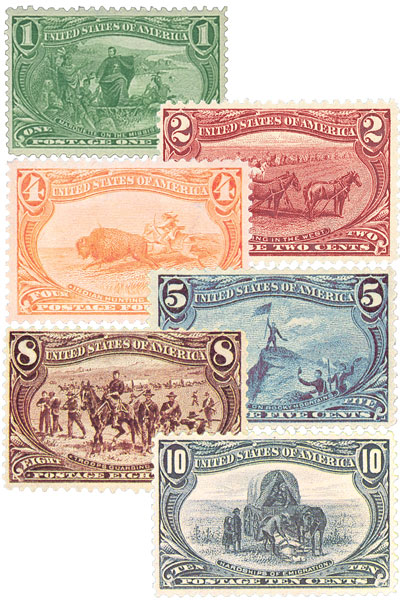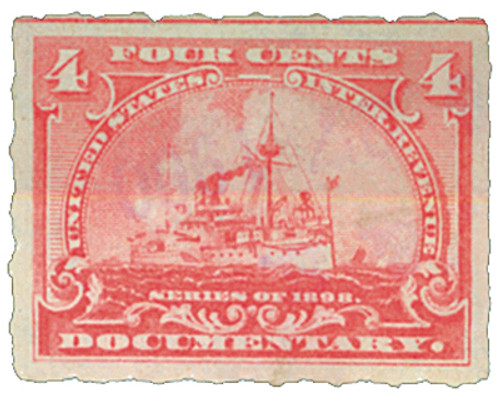
# R164 - 1898 2c US Internal Revenue Stamp -Battleship, carmine rose
U.S. Revenue Stamps – Expand Your Collection or Start a New One
Intricate Revenue stamps feature the rich detail and historical importance of classic U.S. stamps for a fraction of the price. Acquiring a collection of these seldom-seen stamps is easy and affordable with Mystic as your collecting partner.
When the Civil War erupted in 1861, the country was on the verge of bankruptcy. A plan was developed to generate internal revenue – money collected from taxes placed on domestic items such as tobacco, alcohol, medicine, perfume and playing cards. Stamps were provided as proof of payment.
Examining used U.S. Revenue stamps offers a window into the past – the government required several unusual cancellation techniques such as private cancels, manuscript initials and perforated initials.
The same legislation that created these stamps also created the Internal Revenue Service (IRS) and the Bureau of Engraving and Printing (BEP).
Until 1862, specific Revenue stamps were required for many taxable items – leading to a wealth of interesting stamps for modern collectors. Imperforate and “part-perf” error stamps present another challenging – yet affordable – collecting opportunity.
USS Maine Explodes, Ignites War
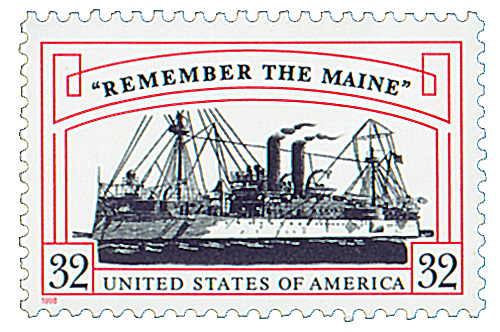
On February 15, 1898, the USS Maine mysteriously exploded in Havana Harbor, leading the U.S. to declare war on Spain two months later.
Christopher Columbus first claimed Cuba for Spain during his voyage there in 1492, though the island was already home to several native groups. Spanish settlers then began to move there in 1511, creating the first permanent European settlement there, Baracoa. Colonists grew sugar cane and tobacco on large plantations, relying on the forced labor of native peoples. Cuba quickly became one of the richest colonies in the West Indies.
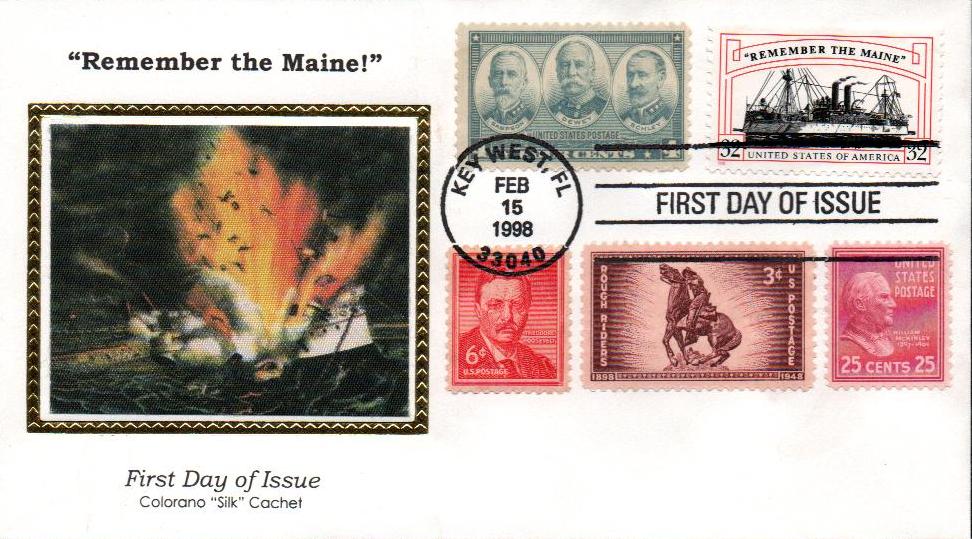
Over time Cuba’s Spanish settlers became increasingly dissatisfied with Spain’s rule. Many revolutionary groups were formed, but little progress was made. By the mid-1800s, many Cubans and Americans favored making Cuba part of the United States. In America, this idea was particularly popular with slave owners who feared Spain would make slavery illegal in Cuba. Other people saw great economic opportunity for the U.S. The U.S. government made several attempts to buy Cuba from Spain, but Spain refused them.
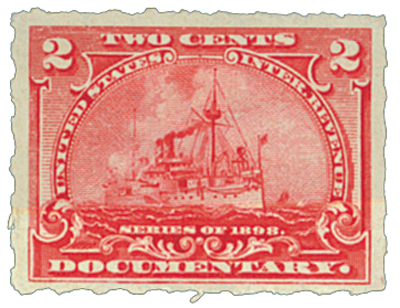
In 1895, José Martí led the Cubans against Spain. This time the Spanish attempted to respond with overwhelming force, deploying more than 200,000 soldiers. Thousands of Cubans were killed in the fighting that ensued. However, by 1898, Spain only controlled Cuba’s main coastal cities. The Spanish were not powerful enough to put down the rebellion, and the rebels were not strong enough to win.
The American press frequently printed stories exaggerating Spain’s oppression of Cubans. This “yellow journalism,” as it came to be called, was used to create more exciting news stories and increase newspaper sales. As a result, many Americans wanted to intervene in the conflict. Additionally, some Americans wanted the U.S. to become an imperial power and create naval and military bases in Cuba. President William McKinley pressured Spain to give Cuba limited self-rule. This was granted in November 1897. This act only further complicated the conflict, as pro-Spain Cubans began rioting in Havana in protest.
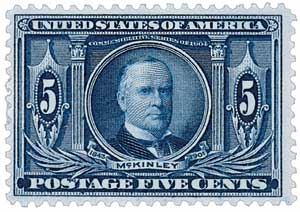
The situation in Cuba led President McKinley to send the battleship Maine to protect American interests. The ship arrived in Havana Harbor on January 25, 1898. On February 15, 1898, the Maine mysteriously exploded while moored in Havana Harbor. Of the ship’s crew of 354, only 88 survived. Although the cause of the explosion has never been conclusively proven (most historians believe the explosion was due to an accident), the American press blamed a Spanish mine, popularizing the slogan “Remember the Maine. To hell with Spain!”
On April 25, 1898, America formally declared that a state of war had existed with Spain since April 21. By August, the Spanish had surrendered. Among the heroes to emerge from the conflict were Theodore Roosevelt and the “Rough Riders.” Roosevelt’s fame later helped him to become president. With this victory, the U.S. emerged as a world power. It also gained the territories of Guam, Puerto Rico, and the Philippine Islands.
Excise taxes were imposed to pay war costs. Revenue tax stamps were created showing a battleship like the Maine. Need for the new revenue stamps forced the Bureau of Engraving and Printing to make adjustments to postage stamps. Namely, the Trans-Mississippi stamps. They were produced in conjunction with the 1898 Trans-Mississippi and International Exposition, whose purpose was to further the progress and development of natural resources west of the Mississippi River.
Although this was supposed to be a 2-color series, the Spanish-American War changed that. The time and manpower needed for 2-color printing was not available. A few short months later, on December 31, 1898, distribution of the stamps was halted. All unsold quantities were recalled and destroyed.
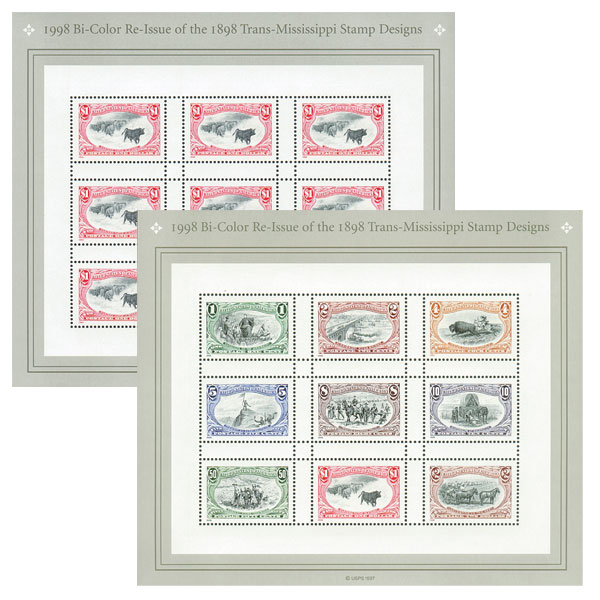
To mark the 100th anniversary of these beautiful and sought-after stamps, the U.S.P.S. issued two souvenir sheets. One pictures all nine stamps as they were originally intended, in two colors. They were even printed using the original bi-color dies. The other souvenir sheet reproduces the $1 issue, the Western Cattle in Storm, which is considered one of the most beautiful, finely engraved stamps ever issued.
U.S. Revenue Stamps – Expand Your Collection or Start a New One
Intricate Revenue stamps feature the rich detail and historical importance of classic U.S. stamps for a fraction of the price. Acquiring a collection of these seldom-seen stamps is easy and affordable with Mystic as your collecting partner.
When the Civil War erupted in 1861, the country was on the verge of bankruptcy. A plan was developed to generate internal revenue – money collected from taxes placed on domestic items such as tobacco, alcohol, medicine, perfume and playing cards. Stamps were provided as proof of payment.
Examining used U.S. Revenue stamps offers a window into the past – the government required several unusual cancellation techniques such as private cancels, manuscript initials and perforated initials.
The same legislation that created these stamps also created the Internal Revenue Service (IRS) and the Bureau of Engraving and Printing (BEP).
Until 1862, specific Revenue stamps were required for many taxable items – leading to a wealth of interesting stamps for modern collectors. Imperforate and “part-perf” error stamps present another challenging – yet affordable – collecting opportunity.
USS Maine Explodes, Ignites War

On February 15, 1898, the USS Maine mysteriously exploded in Havana Harbor, leading the U.S. to declare war on Spain two months later.
Christopher Columbus first claimed Cuba for Spain during his voyage there in 1492, though the island was already home to several native groups. Spanish settlers then began to move there in 1511, creating the first permanent European settlement there, Baracoa. Colonists grew sugar cane and tobacco on large plantations, relying on the forced labor of native peoples. Cuba quickly became one of the richest colonies in the West Indies.

Over time Cuba’s Spanish settlers became increasingly dissatisfied with Spain’s rule. Many revolutionary groups were formed, but little progress was made. By the mid-1800s, many Cubans and Americans favored making Cuba part of the United States. In America, this idea was particularly popular with slave owners who feared Spain would make slavery illegal in Cuba. Other people saw great economic opportunity for the U.S. The U.S. government made several attempts to buy Cuba from Spain, but Spain refused them.

In 1895, José Martí led the Cubans against Spain. This time the Spanish attempted to respond with overwhelming force, deploying more than 200,000 soldiers. Thousands of Cubans were killed in the fighting that ensued. However, by 1898, Spain only controlled Cuba’s main coastal cities. The Spanish were not powerful enough to put down the rebellion, and the rebels were not strong enough to win.
The American press frequently printed stories exaggerating Spain’s oppression of Cubans. This “yellow journalism,” as it came to be called, was used to create more exciting news stories and increase newspaper sales. As a result, many Americans wanted to intervene in the conflict. Additionally, some Americans wanted the U.S. to become an imperial power and create naval and military bases in Cuba. President William McKinley pressured Spain to give Cuba limited self-rule. This was granted in November 1897. This act only further complicated the conflict, as pro-Spain Cubans began rioting in Havana in protest.

The situation in Cuba led President McKinley to send the battleship Maine to protect American interests. The ship arrived in Havana Harbor on January 25, 1898. On February 15, 1898, the Maine mysteriously exploded while moored in Havana Harbor. Of the ship’s crew of 354, only 88 survived. Although the cause of the explosion has never been conclusively proven (most historians believe the explosion was due to an accident), the American press blamed a Spanish mine, popularizing the slogan “Remember the Maine. To hell with Spain!”
On April 25, 1898, America formally declared that a state of war had existed with Spain since April 21. By August, the Spanish had surrendered. Among the heroes to emerge from the conflict were Theodore Roosevelt and the “Rough Riders.” Roosevelt’s fame later helped him to become president. With this victory, the U.S. emerged as a world power. It also gained the territories of Guam, Puerto Rico, and the Philippine Islands.
Excise taxes were imposed to pay war costs. Revenue tax stamps were created showing a battleship like the Maine. Need for the new revenue stamps forced the Bureau of Engraving and Printing to make adjustments to postage stamps. Namely, the Trans-Mississippi stamps. They were produced in conjunction with the 1898 Trans-Mississippi and International Exposition, whose purpose was to further the progress and development of natural resources west of the Mississippi River.
Although this was supposed to be a 2-color series, the Spanish-American War changed that. The time and manpower needed for 2-color printing was not available. A few short months later, on December 31, 1898, distribution of the stamps was halted. All unsold quantities were recalled and destroyed.

To mark the 100th anniversary of these beautiful and sought-after stamps, the U.S.P.S. issued two souvenir sheets. One pictures all nine stamps as they were originally intended, in two colors. They were even printed using the original bi-color dies. The other souvenir sheet reproduces the $1 issue, the Western Cattle in Storm, which is considered one of the most beautiful, finely engraved stamps ever issued.






